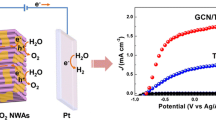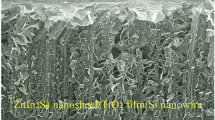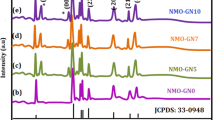Abstract
We report a powerful approach to improve the photoelectrochemical (PEC) performance of the Si/ZnO nanowire array (NWA) photoanodes via incorporating a graphene layer. The Si/Graphene/ZnO NWAs shows the highest photocurrent, which is, respectively, 1.6 times of that for the Si/ZnO NWAs, and 6.2 times of that for the Si wafers. The introducing of ZnO NWAs and graphene greatly reduces the light reflectance, especially in the UV light region. Carrier recombination at the effective n-Si/n-ZnO junction can compensate the high valence band level of Si and thus enhances the contribution of Si to the photocurrent. The graphene interlayers offer a fast passway for the photogenerated electrons in ZnO to recombine with the photogenerated holes in Si, resulting in enhanced PEC performance of the Si/graphene/ZnO NWAs. This study demonstrates the n/graphene/n heterojunction is a promising configuration for efficient solar water splitting.






Similar content being viewed by others
References
Liu S, Tang ZR, Sun Y, Colmenares JC, Xu YJ (2015) One-dimension-based spatially ordered architectures for solar energy conversion. Chem Soc Rev 44:5053–5075
Zhang T, Lin W (2014) Metal-organic frameworks for artificial photosynthesis and photocatalysis. Chem Soc Rev 43:5982–5993
Rahman MZ, Kwong CW, Davey K, Qiao SZ (2016) 2D phosphorene as a water splitting photocatalyst: fundamentals to applications. Energy Environ Sci 9:709–728
Wang J, Zhong HX, Wang ZL, Meng FL, Zhang XB (2016) Integrated three-dimensional carbon paper/carbon tubes/cobalt–sulfide sheets as an efficient electrode for overall water splitting. ACS Nano 10:2342–2348
Frischmann PD, Mahata K, Wurthner F (2013) Powering the future of molecular artificial photosynthesis with light-harvesting metallosupramolecular dye assemblies. Chem Soc Rev 42:1847–1870
Tachibana Y, Vayssieres L, Durrant JR (2012) Artificial photosynthesis for solar water-splitting. Nat Photonics 6:511–518
Bonke SA, Wiechen M, MacFarlane DR, Spiccia L (2015) Renewable fuels from concentrated solar power: towards practical artificial photosynthesis. Energy Environ Sci 8:2791–2796
Zhang R, Shao M, Xu S, Ning F, Zhou L, Wei M (2017) Photo-assisted synthesis of zinc–iron layered double hydroxides/TiO2 nanoarrays toward highly-efficient photoelectrochemical water splitting. Nano Energy 33:21–28
Hikita Y, Nishio K, Seitz LC, Chakthranont P, Tachikawa T, Jaramillo TF, Hwang HY (2016) Band edge engineering of oxide photoanodes for photoelectrochemical water splitting: integration of subsurface dipoles with atomic-scale control. Adv Energy Mater 6:1502154
Sun K, Jing Y, Li C, Zhang X, Aguinaldo R, Kargar A, Madsen K, Banu K, Zhou Y, Bando Y, Liu Z, Wang D (2012) 3D branched nanowire heterojunction photoelectrodes for high-efficiency solar water splitting and H2 generation. Nanoscale 4:1515–1521
Shi M, Pan X, Qiu W, Zheng D, Xu M, Chen H (2011) Si/ZnO core–shell nanowire arrays for photoelectrochemical water splitting. Int J Hydrogen Energy 36:15153–15159
Kargar A, Sun K, Kim SJ, Lu D, Jing Y, Liu Z, Pan X, Wang D (2013) Three-dimensional ZnO/Si broom-like nanowire heterostructures as photoelectrochemical anodes for solar energy conversion. Phys Status Solidi A 210:2561–2568
Bai Z, Zhang Y (2017) A Cu2O/Cu2S–ZnO/CdS tandem photoelectrochemical cell for self-driven solar water splitting. J Alloy Compd 698:133–140
Yang X, Wolcott A, Wang G, Sobo A, Fitzmorris RC, Qian F, Zhang JZ, Li Y (2009) Nitrogen-doped ZnO nanowire arrays for photoelectrochemical water splitting. Nano Lett 9:2331–2336
Chen HM, Chen CK, Chang YC, Tsai CW, Liu RS, Hu SF, Chang WS, Chen KH (2010) Quantum dot monolayer sensitized ZnO nanowire-array photoelectrodes: true efficiency for water splitting. Angew Chem 49:5966–5969
Osterloh FE (2013) Inorganic nanostructures for photoelectrochemical and photocatalytic water splitting. Chem Soc Rev 42:2294–2320
Bai Z, Zhang Y (2016) CdS nanoparticles sensitized large-scale patterned ZnO nanowire arrays for enhanced solar water splitting. J Solid State Electrochem 20:3499–3505
Shao M, Ning F, Wei M, Evans DG, Duan X (2014) Hierarchical nanowire arrays based on ZnO core–layered double hydroxide shell for largely enhanced photoelectrochemical water splitting. Adv Funct Mater 24:580–586
Bu Y, Chen Z, Li W, Hou B (2013) Highly efficient photocatalytic performance of graphene–ZnO quasi-shell–core composite material. ACS Appl Mater Interface 5:12361–12368
Gurudayal Sabba D, Kumar MH, Wong LH, Barber J, Gratzel M, Mathews N (2015) Perovskite–hematite tandem cells for efficient overall solar driven water splitting. Nano Lett 15:3833–3839
Prévot MS, Sivula K (2013) Photoelectrochemical tandem cells for solar water splitting. J Phys Chem C 117:17879–17893
Brillet J, Yum J-H, Cornuz M, Hisatomi T, Solarska R, Augustynski J, Graetzel M, Sivula K (2012) Highly efficient water splitting by a dual-absorber tandem cell. Nat Photonics 6:824–828
Sun K, Madsen K, Andersen P, Bao W, Sun Z, Wang D (2012) Metal on metal oxide nanowire co-catalyzed Si photocathode for solar water splitting. Nanotechnology 23:194013
Kargar A, Sun K, Jing Y, Choi C, Jeong H, Jung GY, Jin S, Wang D (2013) 3D branched nanowire photoelectrochemical electrodes for efficient solar water splitting. ACS Nano 7:9407–9415
Kargar A, Sun K, Jing Y, Choi C, Jeong H, Zhou Y, Madsen K, Naughton P, Jin S, Jung GY, Wang D (2013) Tailoring n-ZnO/p-Si branched nanowire heterostructures for selective photoelectrochemical water oxidation or reduction. Nano Lett 13:3017–3022
Dee CF, Chong SK, Rahman SA, Omar FS, Huang NM, Majlis BY, Salleh MM (2014) Hierarchical Si/ZnO trunk-branch nanostructure for photocurrent enhancement. Nanoscale Res Lett 9:469
Wang Y, Wang F, He J (2013) Controlled fabrication and photocatalytic properties of a three-dimensional ZnO nanowire/reduced graphene oxide/CdS heterostructure on carbon cloth. Nanoscale 5:11291–11297
Yang N, Zhai J, Wang D, Chen Y, Jiang L (2010) Two-dimensional graphene bridges enhanced photoinduced charge transport in dye-sensitized solar cells. ACS Nano 4:887–894
Kang Z, Gu Y, Yan X, Bai Z, Liu Y, Liu S, Zhang X, Zhang Z, Zhang X, Zhang Y (2015) Enhanced photoelectrochemical property of ZnO nanorods array synthesized on reduced graphene oxide for self-powered biosensing application. Biosens Bioelectron 64:499–504
Guo CX, Dong Y, Yang HB, Li CM (2013) Graphene quantum dots as a green sensitizer to functionalize ZnO nanowire arrays on F-doped SnO2 glass for enhanced photoelectrochemical water splitting. Adv Energy Mater 3:997–1003
Kenanakis G, Vernardou D, Koudoumas E, Katsarakis N (2009) Growth of c-axis oriented ZnO nanowires from aqueous solution: the decisive role of a seed layer for controlling the wires’ diameter. J Cryst Growth 311:4799–4804
Bao Z, Xu X, Zhou G, Hu J (2016) Constructing n-ZnO@Au heterogeneous nanorod arrays on p-Si substrate as efficient photocathode for water splitting. Nanotechnology 27:305403
Weng B, Yang M-Q, Zhang N, Xu Y-J (2014) Toward the enhanced photoactivity and photostability of ZnO nanospheres via intimate surface coating with reduced graphene oxide. J Mater Chem A 2:9380
Bai Z, Yan X, Kang Z, Hu Y, Zhang X, Zhang Y (2015) Photoelectrochemical performance enhancement of ZnO photoanodes from ZnIn2S4 nanosheets coating. Nano Energy 14:392–400
Kochuveedu ST, Jang YH, Jang YJ, Kim DH (2013) Visible light active photocatalysis on block copolymer induced strings of ZnO nanoparticles doped with carbon. J Mater Chem A 1:898–905
Foo CY, Sumboja A, Tan DJH, Wang J, Lee PS (2014) Flexible and highly scalable V2O5-rGO electrodes in an organic electrolyte for supercapacitor devices. Adv Energy Mater 4:1400236
Meier U, Pettenkofer C (2005) Morphology of the Si–ZnO interface. Appl Surf Sci 252:1139–1146
Cincotto FH, Canevari TC, Campos AM, Landers R, Machado SA (2014) Simultaneous determination of epinephrine and dopamine by electrochemical reduction on the hybrid material SiO2/graphene oxide decorated with Ag nanoparticles. Analyst 139:4634–4640
Ketteler G, Yamamoto S, Bluhm H, Andersson K, Starr DE, Ogletree DF, Ogasawara H, Nilsson A, Salmeron M (2007) The nature of water nucleation sites on TiO2 (110) surfaces revealed by ambient pressure X-ray photoelectron spectroscopy. J Phys Chem C 111:8278–8282
Xiang HJ, Yang J, Hou JG, Zhu Q (2006) Piezoelectricity in ZnO nanowires: a first-principles study. Appl Phys Lett 89:223111
Noh SY, Sun K, Choi C, Niu M, Yang M, Xu K, Jin S, Wang D (2013) Branched TiO2/Si nanostructures for enhanced photoelectrochemical water splitting. Nano Energy 2:351–360
Roy P, Periasamy AP, Liang CT, Chang HT (2013) Synthesis of graphene-ZnO–Au nanocomposites for efficient photocatalytic reduction of nitrobenzene. Environ Sci Technol 47:6688–6695
Hwang YJ, Boukai A, Yang PD (2009) High density n-Si/n-TiO2 core/shell nanowire arrays with enhanced photoactivity. Nano Lett 9:410–415
Acknowledgements
This work was supported by the Natural Science Foundation of China (NSFC) (51602021), the China Postdoctoral Science Foundation (2015M580979) and the Fundamental Research Funds for the Central Universities (FRF-TP-15-107A1).
Author information
Authors and Affiliations
Corresponding author
Rights and permissions
About this article
Cite this article
Bai, Z., Liu, F., Liu, J. et al. Enhanced photoelectrochemical performance of n-Si/n-ZnO nanowire arrays using graphene interlayers. J Mater Sci 52, 10497–10505 (2017). https://doi.org/10.1007/s10853-017-1235-y
Received:
Accepted:
Published:
Issue Date:
DOI: https://doi.org/10.1007/s10853-017-1235-y




